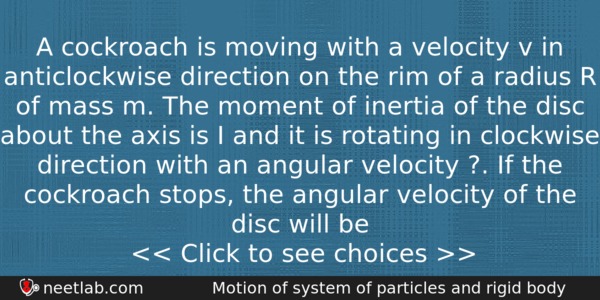| ⇦ | 
| ⇨ |
A cockroach is moving with a velocity v in anticlockwise direction on the rim of a radius R of mass m. The moment of inertia of the disc about the axis is I and it is rotating in clockwise direction with an angular velocity ?. If the cockroach stops, the angular velocity of the disc will be
Options
(a) I?/(I+mR²)
(b) (I?+mvR)/(I+mR²)
(c) (I?-mvR)/(I+mR²)
(d) (I?-mvR)/I
Correct Answer:
(I?-mvR)/(I+mR²)
Explanation:
No explanation available. Be the first to write the explanation for this question by commenting below.
Related Questions:
- If light emitted from sodium bulb is passed through sodium vapour,
- Pick out the correct statements from the following
- A current of 2A flows through a 2Ω resistor when connected across a battery
- The mass of a lift is 2000kg. When the tension in the supporting cable is 28000N, then its acceleration is
- If the angle of minimum deviation is 60° for an equilateral prism, then the refractive
Topics: Motion of system of Particles and Rigid Body
(73)
Subject: Physics
(2479)
Important MCQs Based on Medical Entrance Examinations To Improve Your NEET Score
18000+ students are using NEETLab to improve their score. What about you?
Solve Previous Year MCQs, Mock Tests, Topicwise Practice Tests, Identify Weak Topics, Formula Flash cards and much more is available in NEETLab Android App to improve your NEET score.
Share this page with your friends

Since the phenomenon occurs in the absence of external torque, so applying the law of conservation of angular momentum-
I disc ×ω – mvR = (I disc + mR²)×ω`
ω` = Iω – mvR/ I + mR²
Therefore, option c is correct!